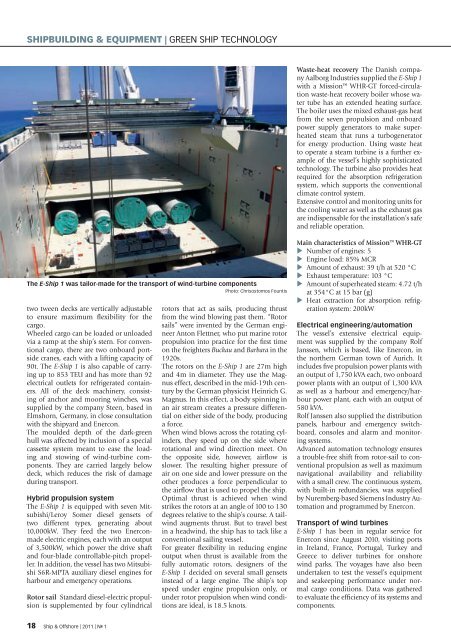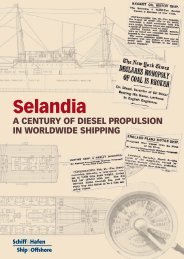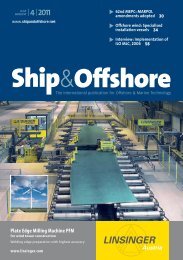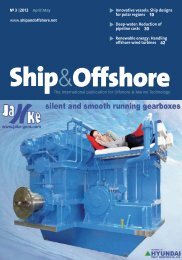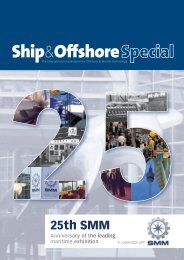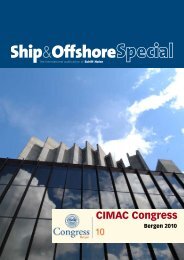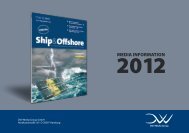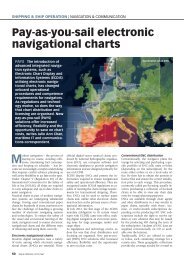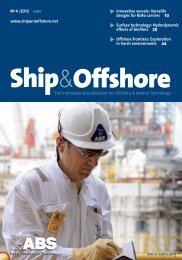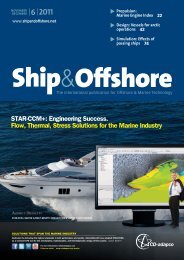Arctic technology: Winterisation of FPSO 38 Cruise ... - Ship & Offshore
Arctic technology: Winterisation of FPSO 38 Cruise ... - Ship & Offshore
Arctic technology: Winterisation of FPSO 38 Cruise ... - Ship & Offshore
You also want an ePaper? Increase the reach of your titles
YUMPU automatically turns print PDFs into web optimized ePapers that Google loves.
SHIPBUILDING & EQUIPMENT | GREEN SHIP TECHNOLOGY<br />
The E-<strong>Ship</strong> 1 was tailor-made for the transport <strong>of</strong> wind-turbine components<br />
Photo: Chrisostomos Fountis<br />
two tween decks are vertically adjustable<br />
to ensure maximum fl exibility for the<br />
cargo.<br />
Wheeled cargo can be loaded or unloaded<br />
via a ramp at the ship’s stern. For conventional<br />
cargo, there are two onboard portside<br />
cranes, each with a lifting capacity <strong>of</strong><br />
90t. The E-<strong>Ship</strong> 1 is also capable <strong>of</strong> carrying<br />
up to 853 TEU and has more than 92<br />
electrical outlets for refrigerated containers.<br />
All <strong>of</strong> the deck machinery, consisting<br />
<strong>of</strong> anchor and mooring winches, was<br />
supplied by the company Steen, based in<br />
Elmshorn, Germany, in close consultation<br />
with the shipyard and Enercon.<br />
The moulded depth <strong>of</strong> the dark-green<br />
hull was affected by inclusion <strong>of</strong> a special<br />
cassette system meant to ease the loading<br />
and stowing <strong>of</strong> wind-turbine components.<br />
They are carried largely below<br />
deck, which reduces the risk <strong>of</strong> damage<br />
during transport.<br />
Hybrid propulsion system<br />
The E-<strong>Ship</strong> 1 is equipped with seven Mitsubishi/Leroy<br />
Somer diesel gensets <strong>of</strong><br />
two different types, generating about<br />
10,000kW. They feed the two Enerconmade<br />
electric engines, each with an output<br />
<strong>of</strong> 3,500kW, which power the drive shaft<br />
and four-blade controllable-pitch propeller.<br />
In addition, the vessel has two Mitsubishi<br />
S6R-MPTA auxiliary diesel engines for<br />
harbour and emergency operations.<br />
Rotor sail Standard diesel-electric propulsion<br />
is supplemented by four cylindrical<br />
18 <strong>Ship</strong> & <strong>Offshore</strong> | 2011 | N o 1<br />
rotors that act as sails, producing thrust<br />
from the wind blowing past them. “Rotor<br />
sails” were invented by the German engineer<br />
Anton Flettner, who put marine rotor<br />
propulsion into practice for the fi rst time<br />
on the freighters Buckau and Barbara in the<br />
1920s.<br />
The rotors on the E-<strong>Ship</strong> 1 are 27m high<br />
and 4m in diameter. They use the Magnus<br />
effect, described in the mid-19th century<br />
by the German physicist Heinrich G.<br />
Magnus. In this effect, a body spinning in<br />
an air stream creates a pressure differential<br />
on either side <strong>of</strong> the body, producing<br />
a force.<br />
When wind blows across the rotating cylinders,<br />
they speed up on the side where<br />
rotational and wind direction meet. On<br />
the opposite side, however, airfl ow is<br />
slower. The resulting higher pressure <strong>of</strong><br />
air on one side and lower pressure on the<br />
other produces a force perpendicular to<br />
the airfl ow that is used to propel the ship.<br />
Optimal thrust is achieved when wind<br />
strikes the rotors at an angle <strong>of</strong> 100 to 130<br />
degrees relative to the ship’s course. A tailwind<br />
augments thrust. But to travel best<br />
in a headwind, the ship has to tack like a<br />
conventional sailing vessel.<br />
For greater fl exibility in reducing engine<br />
output when thrust is available from the<br />
fully automatic rotors, designers <strong>of</strong> the<br />
E-<strong>Ship</strong> 1 decided on several small gensets<br />
instead <strong>of</strong> a large engine. The ship’s top<br />
speed under engine propulsion only, or<br />
under rotor propulsion when wind conditions<br />
are ideal, is 18.5 knots.<br />
Waste-heat recovery The Danish company<br />
Aalborg Industries supplied the E-<strong>Ship</strong> 1<br />
with a Mission WHR-GT forced-circulation<br />
waste-heat recovery boiler whose water<br />
tube has an extended heating surface.<br />
The boiler uses the mixed exhaust-gas heat<br />
from the seven propulsion and onboard<br />
power supply generators to make superheated<br />
steam that runs a turbogenerator<br />
for energy production. Using waste heat<br />
to operate a steam turbine is a further example<br />
<strong>of</strong> the vessel’s highly sophisticated<br />
<strong>technology</strong>. The turbine also provides heat<br />
required for the absorption refrigeration<br />
system, which supports the conventional<br />
climate control system.<br />
Extensive control and monitoring units for<br />
the cooling water as well as the exhaust gas<br />
are indispensable for the installation’s safe<br />
and reliable operation.<br />
Main characteristics <strong>of</strong> Mission WHR-GT<br />
� Number <strong>of</strong> engines: 5<br />
� Engine load: 85% MCR<br />
� Amount <strong>of</strong> exhaust: 39 t/h at 520 °C<br />
� Exhaust temperature: 103 °C<br />
� Amount <strong>of</strong> superheated steam: 4.72 t/h<br />
at 354°C at 15 bar (g)<br />
� Heat extraction for absorption refrigeration<br />
system: 200kW<br />
Electrical engineering/automation<br />
The vessel’s extensive electrical equipment<br />
was supplied by the company Rolf<br />
Janssen, which is based, like Enercon, in<br />
the northern German town <strong>of</strong> Aurich. It<br />
includes fi ve propulsion power plants with<br />
an output <strong>of</strong> 1,750 kVA each, two onboard<br />
power plants with an output <strong>of</strong> 1,300 kVA<br />
as well as a harbour and emergency/harbour<br />
power plant, each with an output <strong>of</strong><br />
580 kVA.<br />
Rolf Janssen also supplied the distribution<br />
panels, harbour and emergency switchboard,<br />
consoles and alarm and monitoring<br />
systems.<br />
Advanced automation <strong>technology</strong> ensures<br />
a trouble-free shift from rotor-sail to conventional<br />
propulsion as well as maximum<br />
navigational availability and reliability<br />
with a small crew. The continuous system,<br />
with built-in redundancies, was supplied<br />
by Nuremberg-based Siemens Industry Automation<br />
and programmed by Enercon.<br />
Transport <strong>of</strong> wind turbines<br />
E-<strong>Ship</strong> 1 has been in regular service for<br />
Enercon since August 2010, visiting ports<br />
in Ireland, France, Portugal, Turkey and<br />
Greece to deliver turbines for onshore<br />
wind parks. The voyages have also been<br />
undertaken to test the vessel’s equipment<br />
and seakeeping performance under normal<br />
cargo conditions. Data was gathered<br />
to evaluate the effi ciency <strong>of</strong> its systems and<br />
components.


